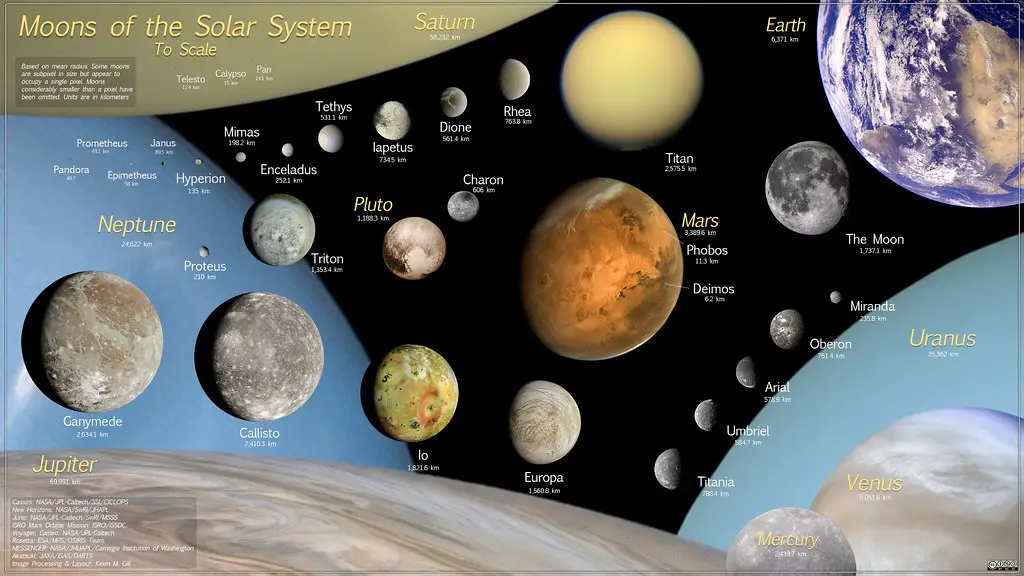Our one and only moon is a captivating sight that greets us when we look up at the vastness of the night sky from our home planet, Earth. For untold years, this heavenly body has guided and inspired poets, painters, and dreamers with its soft glow and tranquil presence. Its gravitational pull has shaped our oceans’ tides and the cycles of life on Earth.
But the moon of Earth is not the only celestial body dancing around in space. It is actually only one of our solar system’s numerous moons. Every moon has its own special mysteries and wonders that are just waiting to be discovered, from the mysterious methane lakes of Saturn’s moon Titan to the majestic tidal forces of Jupiter’s moon Europa.
We discover a patchwork of varied landscapes as we travel deeper into the fascinating world of moons, from ice surfaces to volcanic terrains, and from ancient craters to secret underground waters. The distinctive characteristics and fascinating histories of each moon make the magnificent cosmic symphony that is unfolding in front of our eyes much more fascinating.
Thus, the next time you look up in the night sky, stop and consider how lucky we are to have the Earth’s moon and all the other moons in our solar system. In addition to being heavenly companions, they serve as doors to uncharted territories and breathtakingly beautiful places. Together, let’s set out on this cosmic adventure to discover the mysteries hidden among the alluring moons in our celestial neighborhood.
The Moon Count
There are an incredible number of moons in our enormous and fascinating solar system, each of which performs a beautiful celestial dance. Data that is currently accessible indicates that hundreds, if not thousands, of moons orbit planets and even asteroids with grace. The largest moon in our solar system, Ganymede, is one of the 79 stunning moons that make up the gigantic Jupiter, the most powerful body in the universe. Not long behind, the magnificent Saturn has a decently sized moon population of sixty-two, each with its own special charm and attraction.
Even though terrestrial planets like Earth and Mars have fewer moons than other planets in the solar system, they nevertheless have other celestial companions that contribute to the mysterious beauty of our cosmic neighborhood. Our planet, Earth, is blessed with a single moon, commonly referred to as “The Moon” or “Luna,” which illuminates our nights with a soft glow and serves as the inspiration for innumerable romantic and fantastical stories. Mars, on the other hand, is pleased to have two moons, Phobos and Deimos, each of which adds to the attraction and mystique of the red planet. Both moons are intriguing and fascinating in their own right.
Meanwhile, the vast gravitational attraction of the gas giants residing in the furthest regions of our solar system has drawn in a myriad of satellites, producing an amazing show in the vastness of space. Many moons have found refuge among these gas giants, which include the gorgeous Jupiter and Saturn with their whirling storms and magnificent rings, creating an awe-inspiring cosmic ballet.
There are countless moons strewn all around our solar system, so there are plenty of heavenly treasures to discover and admire. Every moon adds to the breathtaking fabric of our cosmic neighborhood, with unique features, secrets, and stories just waiting to be discovered. It serves as a reminder of the universe’s size and splendor and a call to explore the uncharted regions of our heavenly backyard.
Notable Moons
There are an astounding number of moons in our solar system, representing a wide variety of celestial bodies that never cease to amaze scientists. Jupiter’s moon Ganymede stands out from the rest of these moons due to its exceptional features. It is the largest moon in our solar system and has the rare distinction of being able to generate its own magnetic field.
Turning our focus to Titan, the largest moon of Saturn, we find ourselves in a planet that is truly remarkable. Titan is remarkably similar to Earth in that it has a steady surface liquid and a dense atmosphere. Its captivating qualities and ethereal beauty never cease to astound us and pique our interest in the possibility of life somewhere other than Earth.
Not to be forgotten is Triton, the mysterious moon of Neptune, which has an odd yet fascinating feature: a retrograde orbit. This peculiarity raises the possibility that Triton was ensnared by Neptune’s gravitational pull, adding to the mystery surrounding this mysterious moon. These fascinating facts about the moons in our solar system pique our scientific curiosity and motivate us to explore the mysteries of the cosmos further by serving as a constant reminder of the size and complexity of our cosmic neighborhood.
Final Thoughts
The sheer number of moons in our vast and mysterious solar system underlines the immense diversity and complexity of our cosmic surroundings. Every moon, with its own individual features and interesting orbit patterns, offers a different and captivating view, from the majestic rings of Saturn to the frigid surface of Europa. Investigating these celestial bodies yields a wealth of information and provides important insights into the formation and development of our solar system. Thus, the next time you look up at the captivating night sky, stop and consider the astounding realization that our Moon is only one of hundreds of moons, each of which is essential to the vast scheme of the universe.
Sources
![]()
